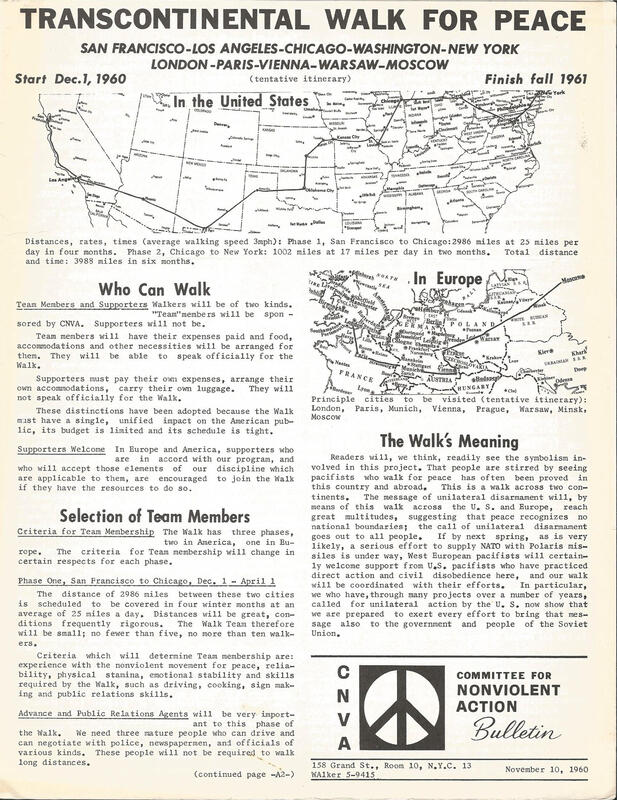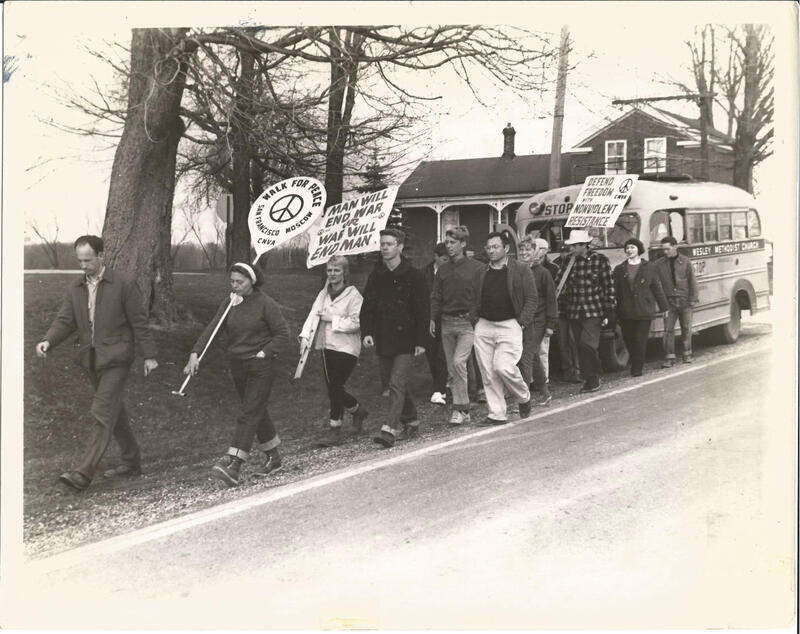|
(click here to view the original post on Facebook)
On this week's Peace of History: We celebrate the anniversary of the “San Francisco to Moscow Walk for Peace,” an incredibly ambitious transnational nuclear disarmament effort which began in December of 1960. Earlier that year, as the Polaris Action summer campaign wound down, several Committee for Non-Violent Action (CNVA) members decided to create a permanent CNVA presence in southeastern Connecticut. These folks would go on to found the Voluntown Peace Trust. But while the CNVA members who stayed in Connecticut decided to focus on the local communities of New London and the surrounding areas, other CNVA members looked toward organizing an ambitious international disarmament campaign. The CNVA, including Bayard Rustin and A.J. Muste, had been involved in other transnational conferences and campaigns for nuclear disarmament, most notably a protest in December 1959 against a French nuclear bomb test in the Sahara Desert, not far from Ghana. Many members of the CNVA were encouraged by the widespread popular Ghanaian support of the Saharan protest, and CNVA was encouraged further by the growing anti-nuclear weapons movement that was especially gaining traction in countries “unaligned” or seeking independence from the imperial powers. But it was the experience of workers at General Dynamics/Electric Boat telling the protestors to “tell it to the Russians” that provided the inspiration for the next campaign after Polaris Action: a “Walk for Peace” from San Francisco to Moscow to encourage disarmament. Within a few short months, CNVA had organized a 310-day, six thousand mile walk that crossed the span of North America, the width of Europe, and ended in Moscow. Activists from eight different European countries would come to join the American walkers, which included the then seventy-six year-old legendary organizer A.J. Muste, as they pressed on east. In most countries, on both sides of the Iron Curtain, the walkers received hospitality and opportunities to present their arguments for unilateral disarmament to average citizens. The only country to reject the walkers was France, but supporters within the country walked the French part of the route themselves, thus doing their part to fulfill the entire itinerary. When the walkers finally reached Moscow, the Soviet government permitted them to hold a 2-hour public vigil in Red Square to protest the Soviet Union’s continued nuclear tests -- the first peace demonstration in the city organized by a Western group since the founding of the Soviet Union. One curious note should be added: this San Francisco to Moscow Walk for Peace was one of the earliest international applications of the now-ubiquitous circular peace symbol. Originally invented in the U.K. in 1958 for the British nuclear disarmament campaign, the symbol was quickly introduced to activists in the United States by Bayard Rustin (best known as the organizer of the 1963 March on Washington) who had attended the march where it was first used. The symbol rapidly gained popularity among American nuclear disarmament activists, and was prominently displayed that same year on one of the sails of The Golden Rule -- the CNVA-crewed ship that pulled various disarmament publicity stunts, frequently finding its way into the photos in newspapers. On the Walk for Peace, several signs carried by the walkers prominently featured the round peace symbol, and as they walked across Europe, these activists may have spread the use of the symbol to these other countries, as well, although that is difficult to confirm. For more information on the Saharan Protest against nuclear weapons testing in Africa, which heavily inspired the CNVA, you can learn more at the Global Nonviolent Action Database: https://nvdatabase.swarthmore.edu/content/international-team-campaigns-against-nuclear-testing-africa-sahara-protest-1959-1960 Next week: We will begin a short series on some of the lovely buildings available for rent at the Voluntown Peace Trust. Comments are closed.
|
AuthorWrite something about yourself. No need to be fancy, just an overview. Archives
March 2023
Categories |



 RSS Feed
RSS Feed